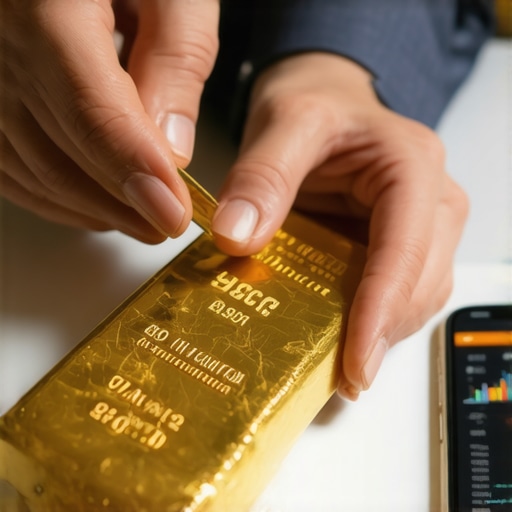Understanding the Investment Landscape: Gold vs. Stocks
When it comes to investing, the debate between gold and stocks has been a long-standing topic among investors and financial advisors alike. Each asset class has its unique benefits and drawbacks, making the decision on which is the better investment option a complex one. In recent years, gold has gained renewed attention as a safe-haven asset, especially during economic uncertainty. But how does it truly compare to stocks in terms of growth potential, stability, and diversification?
The Growth Potential of Stocks
Stocks have long been regarded as one of the most lucrative investment options available. Historically, the stock market has provided higher average returns over the long term, with many investors seeing significant capital appreciation. For example, the S&P 500 has averaged an annual return of around 10% over the past century, making it a compelling option for those looking to grow their wealth.
However, investing in stocks comes with its risks. Market volatility can lead to substantial losses in short periods, and the performance of individual stocks can be influenced by various factors, including company performance, economic conditions, and geopolitical events. Investors must be prepared to endure fluctuations in value and have a solid understanding of market trends to navigate this asset class effectively.
Gold as a Safe-Haven Asset
Gold, on the other hand, has been cherished for centuries as a store of value and a hedge against inflation. Unlike stocks, gold tends to retain its value during economic downturns, making it an attractive option for risk-averse investors. When the stock market experiences a downturn, investors often flock to gold, driving its prices higher. This behavior highlights gold’s role as a stabilizing force in an investment portfolio.
Moreover, gold’s intrinsic value is not tied to the performance of any company or government. This characteristic makes it a unique asset that can provide security when other investments falter. For those interested in understanding how gold can secure financial futures, exploring articles like How Gold as a Hedge Can Secure Your Financial Future can provide deeper insights.
Portfolio Diversification: The Best of Both Worlds
One of the key strategies in investing is diversification. By spreading investments across various asset classes, investors can mitigate risk and enhance potential returns. Including both gold and stocks in an investment portfolio can offer the best of both worlds: the growth potential of stocks and the stability of gold. This balanced approach can protect against market volatility while still allowing for capital appreciation.
For those looking to delve deeper into how gold can fit into a diversified investment portfolio, articles like The Role of Gold in a Diversified Investment Portfolio provide essential insights.
In conclusion, the choice between gold and stocks as an investment option is not clear-cut. Gold presents significant advantages in terms of stability and risk mitigation, while stocks offer growth potential that can significantly enhance wealth over time. Understanding these dynamics is crucial for investors seeking to optimize their portfolios in today’s financial landscape.
Gold’s Performance During Economic Fluctuations
Gold’s reputation as a safe-haven asset is largely due to its performance during economic downturns. When stock markets face volatility, investors often turn to gold as a reliable alternative. This behavior can be attributed to gold’s ability to maintain its value, unlike stocks that may plummet in response to adverse economic news. In times of uncertainty, such as during financial crises or geopolitical tensions, the demand for gold typically surges, leading to price increases.
Investors should consider how gold can act as an insurance policy against economic instability. Articles like Forecasting Gold Prices: Insights and Predictions for 2025 delve into the factors influencing gold’s price during turbulent times, offering a comprehensive view of its potential as a protective investment.
Understanding Gold Demand Trends
The demand for gold is influenced by various factors, including jewelry consumption, industrial use, and investment trends. Jewelry remains the largest segment of gold demand, especially in countries like India and China, where cultural significance drives purchases. Additionally, industrial applications, including electronics and medical devices, further bolster gold’s demand.
Investment demand is particularly notable, as more investors recognize the benefits of adding gold to their portfolios. The growing popularity of gold-backed exchange-traded funds (ETFs) enables investors to gain exposure to gold without the need to buy physical bullion. For a deeper understanding of gold’s demand dynamics, consider exploring Understanding Gold Demand Trends: Predictions for 2025.
The Impact of Central Bank Purchases
Central banks play a crucial role in the gold market. Their purchases and sales can significantly influence gold prices and market sentiment. In recent years, many central banks have increased their gold reserves as a hedge against inflation and currency fluctuations. This shift underscores the growing recognition of gold’s value as a strategic asset in times of economic uncertainty.
Investors should pay attention to central bank purchasing trends, as these actions can signal broader economic conditions. For insights into how central bank gold purchases affect market dynamics, check out Central Bank Gold Purchases: Understanding Their Impact.
Gold versus Stocks: Risk and Volatility
While stocks can offer high returns, they come with inherent risks and volatility that can be unsettling for many investors. The potential for significant losses during market downturns can make stocks a less appealing choice for risk-averse individuals. Gold, conversely, tends to provide a cushion against such volatility, making it a desirable option for those who prioritize stability over aggressive growth.
The contrasting nature of these asset classes emphasizes the importance of understanding one’s risk tolerance when building an investment portfolio. For those seeking to balance risk and reward, incorporating both gold and stocks may be the optimal solution. To read more about effective strategies for balancing investments, consider Top 10 Gold Investment Strategies for 2025 Success.
Future Trends: What Investors Should Anticipate
As we look ahead, several trends could shape the future of gold and its relationship with stock markets. Factors such as inflation, global economic recovery, and technological advancements in gold mining will play pivotal roles in determining gold’s market position. Understanding these trends will help investors make informed decisions about their portfolios.
For those interested in staying ahead of the curve, articles like 2025 Gold Market Dynamics: Key Factors for Investors provide valuable insights into what to watch in the coming years. By remaining informed about the evolving landscape of gold investments, individuals can better position themselves for success in their financial journeys.
Evaluating Gold’s Intrinsic Value and Market Dynamics
Gold’s intrinsic value stems from its unique properties and historical significance. Unlike fiat currencies that are subject to inflationary pressures, gold remains a finite resource with a consistent demand across various sectors. This demand is driven not only by investment trends but also by cultural practices and industrial applications. Investors often seek to understand the intricacies of gold’s market dynamics to maximize their returns.
For instance, gold’s role in electronics and medical devices contributes to its ongoing demand. As technology advances, the need for high-quality gold in these sectors is likely to rise. To gain a better understanding of the factors influencing gold demand, consider exploring A Deep Dive into Gold Demand Trends: What You Need to Know.
Gold’s Relationship with Inflation and Currency Fluctuations
One of the key reasons investors flock to gold is its historical performance as a hedge against inflation. When inflation rises, the purchasing power of currency declines, leading many to invest in tangible assets like gold. This relationship underscores the importance of monitoring economic indicators and understanding how inflation impacts gold prices.
Additionally, currency fluctuations can significantly affect gold’s market value. When the dollar weakens, gold prices often rise, attracting more investors seeking to preserve their wealth. Understanding the interplay between currency strength and gold prices can help investors make informed decisions. For insights into how gold serves as a hedge, check out How Gold as a Hedge Can Secure Your Financial Future.
Strategies for Investing in Gold: ETFs vs. Physical Gold
Investors have multiple options when it comes to investing in gold, primarily through gold exchange-traded funds (ETFs) or physical gold. Gold ETFs offer a convenient way to gain exposure to gold without the need to store or secure physical assets. They trade like stocks on exchanges, providing liquidity and ease of access.
However, some investors still prefer holding physical gold, such as coins or bullion, for its tangible value and historical significance. This choice often depends on individual investment goals and risk tolerance. For those considering the benefits and drawbacks of various gold investment forms, articles like Comparing Gold ETFs vs. Physical Gold: What to Choose can offer valuable insights.
Gold Mutual Funds: A Diversified Approach
Another avenue for investors is gold mutual funds, which pool money from multiple investors to purchase shares in various gold-related assets, including mining companies and gold bullion. This approach provides diversification within the gold market, reducing individual risk while still offering exposure to gold’s potential upside.
Investors should consider their risk appetite and investment horizon when exploring mutual funds. Understanding the nuances of gold mutual funds can empower investors to make informed choices. To learn more about how to navigate this investment type, read Gold Mutual Funds Explained: How to Invest Wisely.
Market Trends Influencing Gold Prices in 2025
As we approach 2025, several market trends are set to influence gold prices significantly. Economic recovery post-pandemic, geopolitical tensions, and shifts in monetary policy are just a few factors that could impact the gold market. Investors need to stay informed about these trends to position themselves effectively.
For example, if inflation continues to rise, gold may see increased demand as a hedge, driving prices higher. Conversely, a stronger dollar may put downward pressure on gold prices. Keeping abreast of these trends will be crucial for investors looking to optimize their portfolios. To explore more about the anticipated gold market dynamics, consider checking out 2025 Gold Market Dynamics: Key Factors for Investors.
Key Considerations for Investing in Gold in 2025
As you navigate the investment landscape, understanding the key considerations for investing in gold will be essential for maximizing your returns. With the ever-evolving market dynamics, it’s crucial to stay informed about the factors influencing gold prices and investment strategies.
Long-Term vs. Short-Term Investments
Investors often face the question of whether to take a long-term or short-term approach to gold investments. Long-term investment strategies typically involve acquiring physical gold or gold ETFs and holding them through market fluctuations, capitalizing on gold’s historical appreciation over time. Conversely, short-term trading can involve leveraging market trends or price fluctuations for quicker profits, but it comes with higher risks. For a comprehensive understanding of both strategies, exploring articles like Top 10 Gold Investment Strategies for 2025 Success can provide valuable insights.
Understanding Market Sentiment and Economic Indicators
Monitoring market sentiment and economic indicators is vital for making informed decisions in gold investments. Factors such as inflation rates, interest rates, and geopolitical developments can significantly influence gold prices. For example, rising inflation often leads to increased demand for gold as a hedge, while a strong dollar may exert downward pressure on prices. Staying updated on these indicators will empower you to time your investments effectively.
Exploring Gold Investment Options: Diversification Strategies
Diversifying your gold investment portfolio can mitigate risks and enhance potential returns. Consider mixing different forms of gold investments, such as physical gold, ETFs, and gold stocks. Each option has unique advantages; for instance, ETFs provide liquidity and ease of trading, while physical gold offers intrinsic value and security. For those looking to compare these options, articles like Comparing Gold ETFs vs. Physical Gold: What to Choose can shed light on the pros and cons of each approach.
The Role of Gold Mining Stocks
Investing in gold mining stocks can also be a lucrative avenue for exposure to the gold market. Mining companies typically benefit from rising gold prices, and investing in their stocks can yield significant returns. However, it’s essential to conduct thorough research on individual mining companies and understand their operational efficiencies and market conditions. For insights into evaluating these investments, consider reading How to Evaluate Gold Stocks in Today’s Market Environment.
Anticipating Future Gold Price Movements
As the investment landscape changes, investors must anticipate future gold price movements to adjust their strategies accordingly. Various trends, including technological advancements in mining and shifts in consumer demand, will shape the market. Keeping an eye on these developments can help investors make informed decisions about when to buy or sell. For a deeper understanding of future trends, articles like The Future of Gold Prices: Key Trends to Watch in 2025 offer valuable predictions.
Conclusion: Crafting Your Gold Investment Strategy
In conclusion, investing in gold in 2025 requires a comprehensive understanding of market dynamics, investment strategies, and risk management. By considering various factors, such as long-term versus short-term investments, market sentiment, and diversification, you can create a robust gold investment strategy that aligns with your financial goals. For further exploration of gold investment insights, visit Investing in Gold: A Comprehensive Guide for 2025.
Frequently Asked Questions About Investing in Gold
1. What are the benefits of investing in gold?
Investing in gold offers several benefits, including serving as a hedge against inflation, providing portfolio diversification, and retaining intrinsic value during economic downturns. Gold is considered a safe-haven asset that can protect wealth when other investments are volatile.
2. How do gold ETFs differ from physical gold?
Gold ETFs allow investors to gain exposure to gold without the need to store physical bullion. They trade like stocks on exchanges, providing liquidity and ease of access. In contrast, physical gold involves purchasing coins or bars, which requires secure storage but offers tangible ownership.
3. Is gold a good long-term investment?
Gold has historically been viewed as a reliable long-term investment, especially during times of economic uncertainty. Its ability to preserve value over time makes it attractive for investors seeking stability in their portfolios.
4. What factors influence gold prices?
Gold prices are influenced by various factors, including inflation rates, currency fluctuations, interest rates, and geopolitical tensions. Understanding these dynamics is crucial for making informed investment decisions.
5. How can I include gold in my investment portfolio?
To include gold in your investment portfolio, consider a mix of gold ETFs, physical gold, and gold mining stocks. Diversification across these different forms can help mitigate risks while still allowing for potential returns.
6. What role do central banks play in the gold market?
Central banks significantly influence the gold market through their purchases and sales of gold reserves. Their actions can affect market sentiment and gold prices, making it important for investors to monitor central bank trends.
7. How can I evaluate gold mining stocks?
When evaluating gold mining stocks, consider factors such as the company’s production costs, operational efficiency, management team, and market conditions. Researching individual companies will help you make informed investment choices.
8. Should I invest in gold during a recession?
Investing in gold during a recession can be a strategic move, as gold often retains its value when other assets decline. It can serve as a buffer against economic instability, making it a wise addition to a recession-proof portfolio.
9. What are gold mutual funds?
Gold mutual funds pool money from multiple investors to purchase shares in various gold-related assets, such as mining companies and gold bullion. This approach provides diversification within the gold market while reducing individual risk.
10. How do I stay updated on gold market trends?
To stay updated on gold market trends, follow trusted financial news sources, subscribe to market analysis newsletters, and read expert opinions. Websites like Kitco and World Gold Council provide valuable insights into market dynamics.
Authority Resources for Gold Investment Insights
When researching gold investment, it’s essential to rely on trusted sources for accurate information. Here are some recommended resources:
- Kitco – A leading precious metals retailer that offers market news, expert analysis, and live gold prices.
- World Gold Council – An organization that provides research and insights on gold demand, trends, and investment strategies.
- Investopedia – A comprehensive resource for financial education, including articles on gold investing.
- BullionVault – A platform that allows individuals to buy and sell physical gold and silver, along with market insights.
- Zacks Investment Research – Offers analysis and ratings on gold stocks and ETFs.
Conclusion: Navigating the Gold Investment Landscape
In summary, investing in gold in 2025 presents a unique opportunity to diversify your portfolio while hedging against economic uncertainties. By understanding the key factors influencing gold prices, exploring various investment options, and staying informed about market trends, you can craft a robust gold investment strategy. Whether you choose gold ETFs, physical bullion, or mining stocks, ensuring that your investments align with your financial goals will position you for success in the dynamic investment landscape. For further insights, remember to consult reliable resources and stay updated on market developments.










The discussion about the balance between gold and stocks really highlights the importance of diversification in a portfolio. From my experience, relying solely on stocks can expose you to significant volatility, especially during economic downturns. Gold’s role as a hedge against inflation and its stability during uncertain times makes it a valuable component for risk-averse investors. However, it’s crucial to recognize that gold typically lacks the same long-term growth potential that equities can offer. I’ve found a mix of gold ETFs and carefully selected stocks has helped my portfolio weather market fluctuations while still growing over time. Additionally, recognizing the impact of central bank gold purchases on market trends is often overlooked but key for anticipating price movements. Overall, this comprehensive look at gold versus stocks emphasizes that neither is inherently better; rather, their complementary roles are what make smart investment strategies successful.